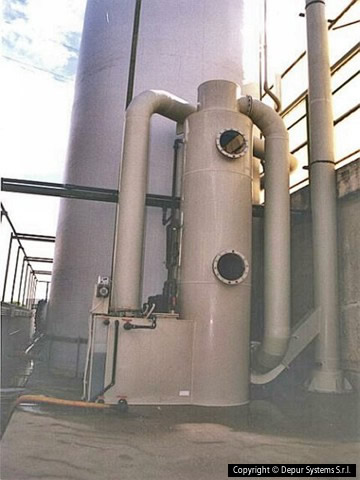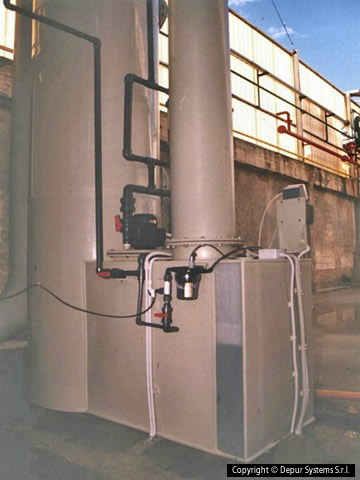
1. Type of technology: wet reducing/ absorption.
2. Folding pollutants: water-soluble substances.
3. Emission limits reachable: it is possible to reach collection efficiencies higher than 97%. 4. Description of equipment and / or process the wet scrubber or scrubber is the most ancient and simple system of purification of polluted gaseous stream. The principle of operation consists in conveying the contaminated air into a chamber within which is achieved through appropriate and different technologies, an intimate contact between the air itself and a certain amount of water, so as to obtain a transfer of pollutants from air to water, to allow the discharge to atmosphere with a concentration of pollutants within the limits of the treated air. Downstream of the scrubber cleaning process is usually found as by-products such as sludge to be disposed of in compliance with public health and the environment. The sludge may be first subjected to dehydration and then compacted to make them suitable for transportation to be, if a non-toxic nature, buried in landfills authorized, or otherwise disposed of or incinerated in plants specially equipped for this purpose. The vivacity of the interaction air-water and the percentage of pollutants transmitted from air to water, are strongly influenced by both the technology applied and the type of design and construction of the chosen filter. Apart from any consideration for the necessary mathematical formulas related to the study and design of the plant, are no less important in this case, the empirical data of which any manufacturer could use reflection to their own experiences. When a particle of the pollutant is "captured" by a given body of water or drop of liquid, it becomes an integral part, it shares the fate and follows closely the path required by the manufacturer to come up in recycle water collected in a special settling tank and then discharged for the final treatment. Underlying all this is essential that the assumptions made in the above, namely: - an air-liquid contact area in which most favors the possible meeting between the union and the particle to be captured and the liquid intended for the purpose; - a settling zone wherein the particles of liquid are separated from the main flow of air; - an area of retention and recovery of the solid particle (if any) with appropriate mechanical systems. The latter also have the task of keeping the water clean as possible by recycling components sedimentous and muddy. Accordingly, it is useful to remember that there are various types of scrubbers that are characterized by: - type of killing - model - dimensions - performance and the choice of either type is strictly subject to certain factors that should be a priority evaluated from time to time, including: - Chemical and physical pollution by capturing, - the source of emissions - the corrosive power of the gaseous effluent, - the duty required.
Plants type
Depur Systems Srl. manufactures a series of very large scrubber belonging to two distinct types, each produced in a wide variety of sizes and performance. They identify with: - Scrubber tower (or scrubbers) are in turn divided into three categories:
• bodies to fill;
• a flat bed;
• floating beds.
Scrubber.
The scrubber is undoubtedly the scrubber classic par excellence, high removal efficiency, known everywhere for unquestioned inherent performance and reliability in terms of maintenance over time of the limits imposed. This is a product developed in the vertical that contains a certain amount of filling bodies, which varies for flow of air and always in the narrower than a contact time and a speed of passage of air to be calculated from time to timeaccording to the specific needs of the user. Of reflection is important that it is provided and maintained also a certain amount of water or washing liquid in order to maintain high and constant efficiency of the scrubber. To some extent reduce the amount of the liquid. May be useful (under certain conditions) cooling the gas stream before it enters the column. The volume and the particular shape of the filling bodies must be determined in such a way that they impose to the pollutants to be removed abrupt changes of direction, so as to intercept the particles better and at the same time provide the maximum contact surface at the same time leaving the maximum spacepossible crossing of the air, thus minimizing the load losses. The materials generally used are metal, ceramics and thermoplastics in general. In the event that have been selected by the manufacturer the plates instead of filtering the bodies, the tower is always presented as a container vertically developed in which the air is forced back to the inside of the room bubbling through several perforated plates (generally two or three places in series at different heights) on the surface of which is maintained a certain layer of liquid. The scrubber beds contain spherical bodies floating very light and similar to filling bodies, rather than being static are placed in constant motion due to air that touches their outer walls.

Good working conditions.
In theory, the efficiency should be higher in the scrubber with filling bodies, but the practice informs that the systems are equivalent in almost all conditions of work and employment, to the benefit of the body less prone to static forces and abrasive wear. The types of plants wet described are all characterized by efficiency values comparable with each other and variable as a function of flow rates (the air-wash liquid), the characteristics of the pollutants and the power of interaction between the polluting particles and the droplets of water. Basically you can say that the smaller particles are pollutants (this is particularly true for dust), the harder it is to separate them from the gas flow and the greater is the energy that must be supplied to the washing water because efficiency overall remains within the desired range. Regardless of this fact, the smooth operation and high filtration efficiency of a scrubber requires a manufacturer to study and correct sizing of the entire filter as a whole in addition to the properties and characteristics of the air section input and the output of the scrubber. The data on the input section obviously depend on the type and characteristics of local activities that produce pollutants to be removed, while those related to the output section are closely related to the tabular limits are enforced to the fireplace, against which can be necessary the realization of an additional filtering system to be connected downstream of the scrubber. It 's also advisable, and that the designer knows, under study include an adequate safety margin so that the plant can compensate for abnormal operating conditions and results in line with both legislative updates and future shortages of values and quantity limit imposed pollutants that enter the plant. The parameters of construction and design data that still must be made known to the manufacturer are: - air flow to be treated - stream temperature - pollution and its chemical composition - Material Safety Data Sheet and risk - aggressive chemical pollutant - particle size, density , explosiveness and hygroscopicity. Only in the presence of this data will be the designer, even on the basis of experiences, to establish with reasonable accuracy the type of intervention, the system design, its filtration efficiency, the volume of water required to saturate and capture the 'polluting and frequency maintenance to maintain high system performance. Some of these points can be developed with the help of formulas, diagrams and technical knowledge, while others can only be established through the experience of the manufacturer.
Conclusions
Abatement systems or wet scrubbers are generally excellent alternative to many other systems of different technology (dry, adsorption, etc..) With respect to almost all the problems of environmental impact of large and medium industries, and they are increasingly being taken into account in the possible configurations of systems for the purification of dangerous substances can be in the form of particles (dust, mist or fumes) of that acid fumes. Recent applications have given very encouraging results even in those processes in which the scrubber was subjected to high temperatures ('200 ° C), as for example in output from incineration plants (after pre-cooling of the fumes with appropriate heat exchangers and quenching) or boilers installed by the wood industries. Were then made different experiences of fumes from smelters and cement plants, and almost all that can be considered more valuable and in line with expectations so much so that the system described is an acknowledged reality. In this regard, however, it is necessary to make the following considerations: - when the air to be treated has a large content of solid particles (dust medium specific weight and the dynamic diameter between 20 and 200 uM with concentration at the entrance of more than 10 / 20 g/m3 of air) is well fitted upstream of the scrubber a filter unit of the mechanical type or cyclonic (or multiciclonico), in order to avoid unnecessary clogging of the ducts, of the filling bodies, recirculating water and the decanter sludge. In case of very high air temperatures, it is advisable to install a cooling coil or heat exchanger, to increase the concentration of pollutants and ensure long life to the ducts and the system itself. The temperature must never be pulled down below the midpoint of the dew of pollutants (30 ° C) and can be obtained: • • using heat recovery by injecting cold water in the pipes by means of a quench. The latter method, however, must be used with extreme caution and only in the absence of pollutants that can produce at contact with water, the formation of corrosive acids for the ducts and the inlet scrubber. The use of dilution of the flow by the mixture of false air is also inconvenient because it requires an increase in size of the implant with consequent costs of investment and management higher. - Since the pressure drop of the water purification systems with scrubber can be highly variable during operation, it is necessary to choose fans with such characteristics as to overcome any swings up or down of these losses, while maintaining as constant as possible the flow of air . The relative suction fan will be placed in most cases downstream of the filter in such a way that the impeller showing hit by air already has been cleaned of pollutants and is then eliminated the risk of abrasion and corrosion that the pollutant can exert on it . This offers the possibility to use fans as valuable as for example those reverse blades, the most appropriate to avoid Accumoli of dust and corrosive substances in the impeller. Is realized also in the maintenance of depression with respect to the atmosphere of that part of the plant in which circulates the gas still polluted, thus eliminating the danger of infection outside. The use of the fan downstream also allows the necessary periodic inspections on the same also with the system in motion without danger of leakage of toxic substances.
